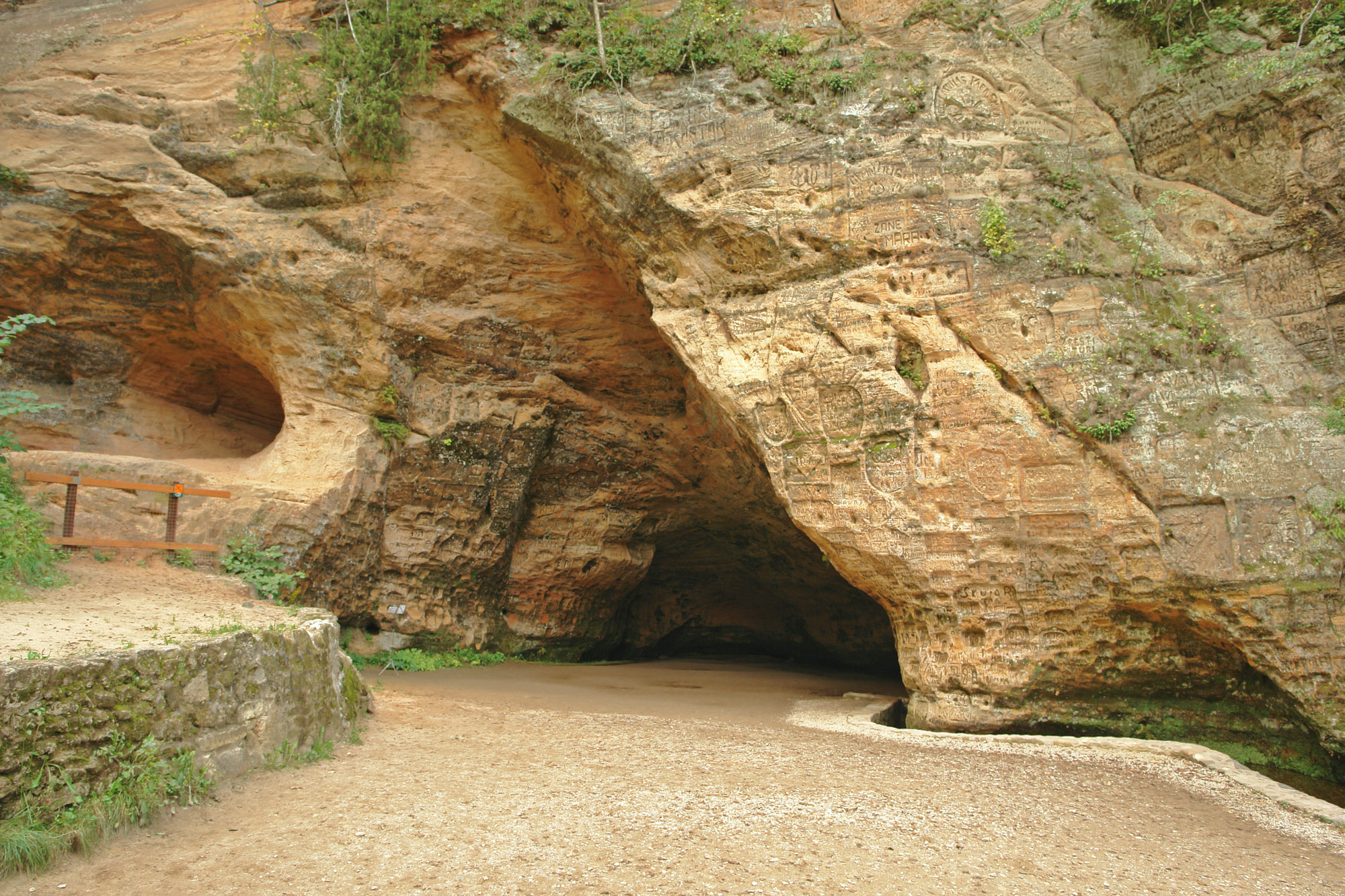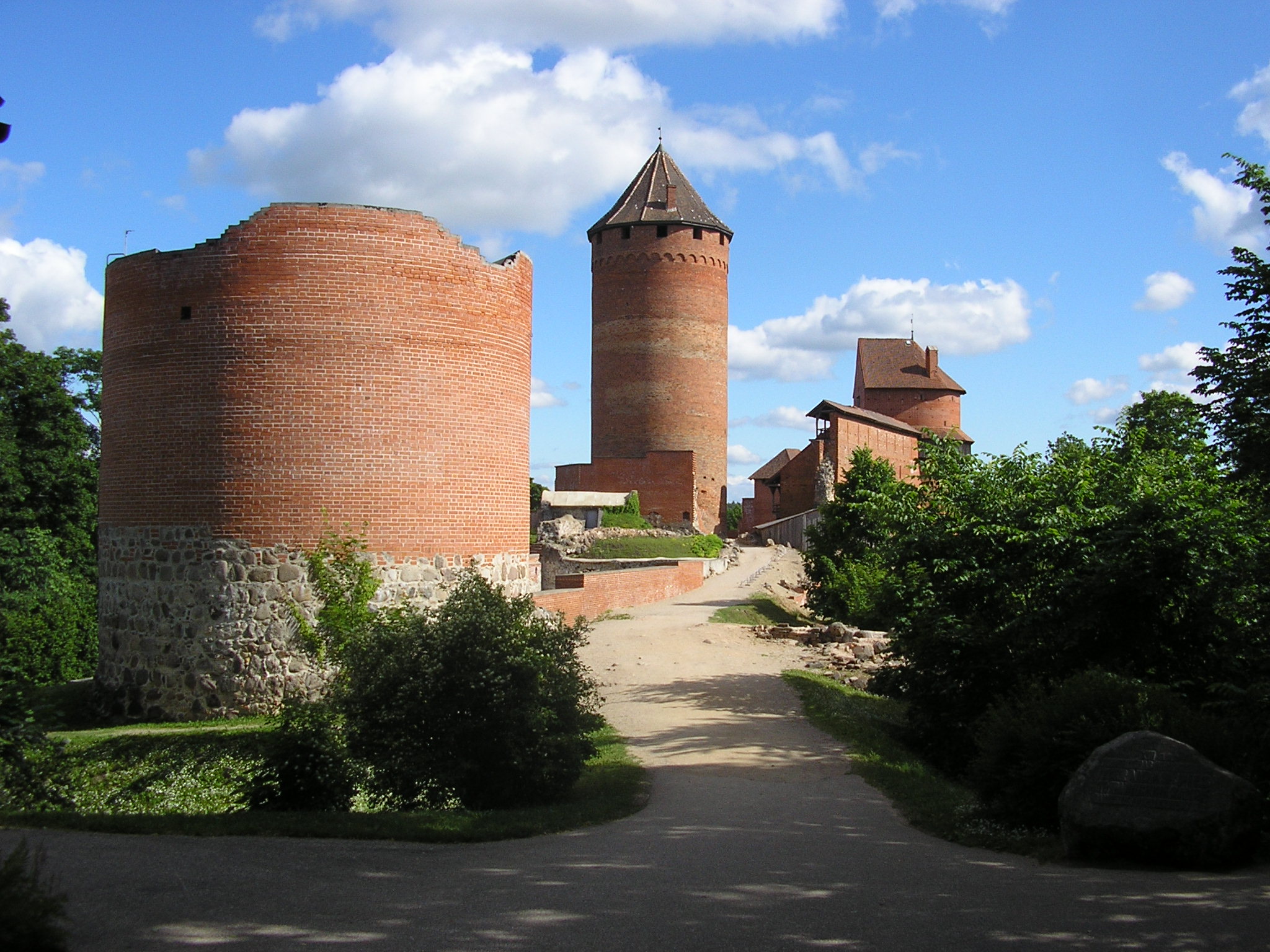|
Gutmanis Cave
Gutman's Cave ( lv, Gūtmaņa ala) is the widest and highest cave in the Baltic countries, located by the Gauja River in the area known as the in the Gauja National Park near Sigulda, Latvia. It started forming more than 10,000 years ago when meltwater eroded the sandstone rock after the Ice Age. It is the oldest tourist attraction in Latvia. On the walls of the cave are inscriptions from the 17th century. The legend of the Rose of Turaida began in this cave. Description Gutman's Cave is the widest and highest cave in the Baltics. It is 18.8 meters deep, 12 meters wide and 10 meters high. The cave was formed from the yellow-brown sandstone rock of the Gauja river bank; its formation is due to a millennium long interaction between the river and an underground spring. The cave is considered the oldest tourist attraction in Latvia because visitors, from even the earliest days, have left “decorations” such as names, initials and the dates of their visits engraved on the wall ... [...More Info...] [...Related Items...] OR: [Wikipedia] [Google] [Baidu] |
Sigulda
Sigulda (; german: Segewold, pl, Zygwold, russian: Сигулда) is a town in the Vidzeme region of Latvia, from the capital city Riga. Overview Sigulda is on a picturesque stretch of the primeval Gauja river valley. Because of the reddish Devonian sandstone which forms steep rocks and caves on both banks of the river, Sigulda has been called the "Switzerland of Vidzeme". After the restoration of Latvian independence in 1991, an emphasis was placed on conserving Sigulda's public monuments and parks as well as improving the town's tourist sector. Supported by the town council, a traditional Opera Festival takes place in an open-air music hall in the castle ruins each summer. A Town Festival is celebrated in May when cherry trees blossom, while Sigulda is known for the colors of its trees in autumn. Sports such as skiing, bobsledding, and the luge are popular in wintertime and bungee jumping is practiced during the rest of the year. The Gutmanis Cave lies halfway between Siguld ... [...More Info...] [...Related Items...] OR: [Wikipedia] [Google] [Baidu] |
Latvian Mythology
Latvian mythology is the collection of myths that have emerged throughout the history of Latvia, sometimes being elaborated upon by successive generations, and at other times being rejected and replaced by other explanatory narratives. These myths stem from folk traditions of the Latvian people and pre-Christian Baltic mythology. Latvian mythology is used particularly as a tool for reconstructing and analysing the historical pagan beliefs and national identity of Latvia. It is important to note that the minute details of most, if not all of these myths vary per region and sometimes even family. History 13th–18th century There are few reports of Baltic tribes, the ancestors of modern Latvians, and their mythology until Christianization in the 13th century. Since Christianization, there have been several reports related to local mythology including chronicles, travel reports, visitation records, Jesuit reports and other accounts of pagan practices. These reports are considered ... [...More Info...] [...Related Items...] OR: [Wikipedia] [Google] [Baidu] |
Vidzeme
Vidzeme (; Old Latvian orthography: ''Widda-semme'', liv, Vidūmō) is one of the Historical Latvian Lands. The capital of Latvia, Riga, is situated in the southwestern part of the region. Literally meaning "the Middle Land", it is situated in north-central Latvia north of the Daugava River. Sometimes in German, it was also known as ''Livland'', the German form from Latin ''Livonia'', though it comprises only a small part of Medieval Livonia and about half (the Latvian part) of Swedish Livonia. Most of the region's inhabitants are Latvians (85%), thus Vidzeme is the most ethnically Latvian region in the country. The historic Governorate of Livonia is also larger than Vidzeme, since it corresponds roughly to Swedish Livonia. History In ancient times, the territory of Vidzeme was inhabited by Latgalians and Livs (near the coast of the Gulf of Riga and along the lower reaches of the Daugava and Gauja rivers). Until the German conquest in the 13th century the Daugava, which now ... [...More Info...] [...Related Items...] OR: [Wikipedia] [Google] [Baidu] |
Turaida
Turaida () is a part of Sigulda in the Vidzeme Region of Latvia. Its most famous site is the Brick Gothic Turaida Castle. In 1212, a peace treaty was signed in Turaida between the Estonian tribes and the Livonian Brothers of the Sword, the Archbishopric of Riga, the Livonians and the Latgalians Latgalians (, nds, Letti, Lethi, modern ; variant translations also include Latgallians, Lettigalls or Lettigallians) were an ancient Baltic tribe. They likely spoke the Latvian language, which probably became the ''lingua franca'' in present-d .... External linksTuraida website Villages in Latvia {{Latvia-geo-stub ... [...More Info...] [...Related Items...] OR: [Wikipedia] [Google] [Baidu] |
Sigulda Castle
Sigulda Castle also known as Sigulda New Castle ( lv, Siguldas jaunā pils). Built in 1878 in the Neo-Gothic style as the living house for the owners of the manor, the Kropotkin family. The building has changed its owners and functions several times. Since 1993, the Sigulda Region Council has been located in the castle. History The manor center began to develop in the fore-castle area of Sigulda Medieval Castle during the 17th century. There are still a few remaining 18th and 19th century buildings built during the ownership of the Von Borghs and Kropotkins. These are the Summer Castle, the New Castle, the White Castle, the vagar's (supervisor of serfs) house, the servants' house, a barn, a laundry house and a vegetable and fruit basement. The manor center is enclosed by chipped boulder walls with a splendid gate structure. The New Castle was built during the time of Duchess Olga and Duke Dimitry Kropotkins from 1878 until 1881 using the materials from an older building which st ... [...More Info...] [...Related Items...] OR: [Wikipedia] [Google] [Baidu] |
Turaida Castle
Turaida Castle ( lv, Turaidas pils, german: Treiden, Treyden, russian: Турайдский замок; meaning ''Thor's garden'' in Livonian) is a recently reconstructed medieval castle in Turaida, in the Vidzeme region of Latvia, on the opposite bank of the Gauja River from Kurzeme. History Turaida castle dominates the Museum Reserve and is visually its most impressive element. When seen from the air, or the opposite bank of the river Gauja in Sigulda, Turaida castle can be seen rising above the treeline. From this view, the forepart of the castle is formed by the northern forecastle's gate tower. The main tower which is the highest is situated centrally, and the rear view forms the southern forecastle with its tower shaped southern section. Construction of the castle was started in 1214 upon directions given by Albert, Archbishop of Riga to his Livonian Brothers of the Sword (soon to merge with the Teutonic Order) at the place where the wooden castle of Livonians had previo ... [...More Info...] [...Related Items...] OR: [Wikipedia] [Google] [Baidu] |
Polish–Swedish Wars
The Polish–Swedish Wars were a series of wars between the Polish–Lithuanian Commonwealth and Sweden. Broadly construed, the term refers to a series of wars between 1563 and 1721. More narrowly, it refers to particular wars between 1600 and 1629. These are the wars included under the broader use of the term: *the 16th century conflict sometimes referred to as the Livonian War (1558–1583) *the Northern Seven Years' War (1563–1570) *the War against Sigismund, in 1598 *the war of 1600–1629 (sometimes considered a part of the larger trans-European Thirty Years' War) which was twice interrupted by periods of truce and can be divided into: **the war of 1600–1611 **the war of 1617–1618 **the war of 1621–1625 **the war of 1626–1629 *the conflicts in the second half of the 17th century known as The Deluge (part of Northern Wars 1655–1661) *the Great Northern War (1700–1721). *the War of the Fourth Coalition (1806–1807), in which Poland, by then partitioned, w ... [...More Info...] [...Related Items...] OR: [Wikipedia] [Google] [Baidu] |
Album Von Dorpat, TKM 0031H 23, Crop
An album is a collection of audio recordings issued on compact disc (CD), vinyl, audio tape, or another medium such as digital distribution. Albums of recorded sound were developed in the early 20th century as individual 78 rpm records collected in a bound book resembling a photograph album; this format evolved after 1948 into single vinyl long-playing (LP) records played at rpm. The album was the dominant form of recorded music expression and consumption from the mid-1960s to the early 21st century, a period known as the album era. Vinyl LPs are still issued, though album sales in the 21st-century have mostly focused on CD and MP3 formats. The 8-track tape was the first tape format widely used alongside vinyl from 1965 until being phased out by 1983 and was gradually supplanted by the cassette tape during the 1970s and early 1980s; the popularity of the cassette reached its peak during the late 1980s, sharply declined during the 1990s and had largely disappe ... [...More Info...] [...Related Items...] OR: [Wikipedia] [Google] [Baidu] |
Rose Of Turaida
The Legend about Turaida Rose (sometimes Rose of Sigulda) is a 19th century legend about a young woman named Maija murdered in the Gutman's Cave and whose grave, in the grounds of Turaida Castle in Latvia, is still much visited. In 19th century court documents were found (and publicized in 1848) which relate events that served a base for the legend. The legend entered into literary circulation and in other forms of art."Leģenda par Turaidas Rozi" Turaida Museum Reserve The same 1848 year the Baltic-German poet Adelbert Cammerer published the poem ''Die Jungfrau von Treiden''. [...More Info...] [...Related Items...] OR: [Wikipedia] [Google] [Baidu] |
Latvian Language
Latvian ( ), also known as Lettish, is an Eastern Baltic language belonging to the Baltic branch of the Indo-European language family, spoken in the Baltic region. It is the language of Latvians and the official language of Latvia as well as one of the official languages of the European Union. There are about 1.3 million native Latvian speakers in Latvia and 100,000 abroad. Altogether, 2 million, or 80% of the population of Latvia, speak Latvian. Of those, around 1.16 million or 62% of Latvia's population use it as their primary language at home, however excluding the Latgale Region it is spoken as a native language in villages and towns by over 90% of the population. As a Baltic language, Latvian is most closely related to neighboring Lithuanian (as well as Old Prussian, an extinct Baltic language); however Latvian has followed a more rapid development. In addition, there is some disagreement whether Latgalian and Kursenieki, which are mutually intelligible with Latvian, s ... [...More Info...] [...Related Items...] OR: [Wikipedia] [Google] [Baidu] |




